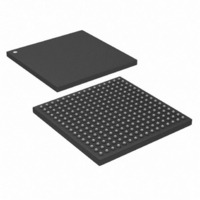DS26528G+ Maxim Integrated Products, DS26528G+ Datasheet - Page 25

DS26528G+
Manufacturer Part Number
DS26528G+
Description
IC TXRX T1/E1/J1 OCT 256-CSBGA
Manufacturer
Maxim Integrated Products
Type
Transceiverr
Datasheet
1.DS26528G.pdf
(276 pages)
Specifications of DS26528G+
Number Of Drivers/receivers
4/4
Protocol
IEEE 1149.1
Voltage - Supply
3.135 V ~ 3.465 V
Mounting Type
Surface Mount
Package / Case
256-CSBGA
Lead Free Status / RoHS Status
Lead free / RoHS Compliant
- Current page: 25 of 276
- Download datasheet (2Mb)
REFCLKIO
DIGIOEN
RESETB
JTCLK
NAME
JTRST
MCLK
JTMS
JTDO
JTDI
PIN
J12
B7
A7
D8
K4
H4
L5
F5
J4
impedance
I, Pullup
I, Pullup
I, Pullup
I, Pullup
O, High
TYPE
I/O
I
I
I
Master Clock. This is an independent free-running clock whose input can be a
multiple of 2.048MHz ±50ppm or 1.544MHz ±50ppm. The clock selection is
available by bits MPS0 and MPS1 and FREQSEL. Multiple of 2.048MHz can be
internally adapted to 1.544MHz. Multiple of 1.544MHz can be adapted to
2.048MHz. Note that TCLK must be 2.048MHz for E1 and 1.544MHz for T1/J1
operation. See
Reset Bar. Active-low reset. This input forces the complete DS26528 reset. This
includes reset of the registers, framers, and LIUs.
Reference Clock Input/Output
Input: A 2.048MHz or 1.544MHz clock input. This clock can be used to generate
the backplane clock. This allows for the users to synchronize the system
backplane with the reference clock. The other options for the backplane clock
reference are LIU-received clocks or MCLK.
Output: This signal can also be used to output a 1.544MHz or 2.048MHz reference
clock. This allows for multiple DS26528s to share the same reference for
generation of the backplane clock. Hence, in a system consisting of multiple
DS26528s, one can be a master and others a slave using the same reference
clock.
Digital Enable. When this pin and JTRST are pulled low, all digital I/O pins are
placed in a high-impedance state. If this pin is high the digital I/O pins operate
normally. This pin must be connected to V
JTAG Reset. JTRST is used to asynchronously reset the test access port
controller. After power-up, JTRST must be toggled from low to high. This action
sets the device into the JTAG DEVICE ID mode. Pulling JTRST low restores
normal device operation. JTRST is pulled high internally via a 10kΩ resistor
operation. If boundary scan is not used, this pin should be held low.
JTAG Mode Select. This pin is sampled on the rising edge of JTCLK and is used
to place the test access port into the various defined IEEE 1149.1 states. This pin
has a 10kΩ pullup resistor.
JTAG Clock. This signal is used to shift data into JTDI on the rising edge and out
of JTDO on the falling edge.
JTAG Data In. Test instructions and data are clocked into this pin on the rising
edge of JTCLK. This pin has a 10kΩ pullup resistor.
JTAG Data Out. Test instructions and data are clocked out of this pin on the falling
edge of JTCLK. If not used, this pin should be left unconnected.
SYSTEM INTERFACE
25 of 276
TEST
Table
9-12.
FUNCTION
DS26528 Octal T1/E1/J1 Transceiver
DD
for normal operation.
Related parts for DS26528G+
Image
Part Number
Description
Manufacturer
Datasheet
Request
R

Part Number:
Description:
MAX7528KCWPMaxim Integrated Products [CMOS Dual 8-Bit Buffered Multiplying DACs]
Manufacturer:
Maxim Integrated Products
Datasheet:

Part Number:
Description:
Single +5V, fully integrated, 1.25Gbps laser diode driver.
Manufacturer:
Maxim Integrated Products
Datasheet:

Part Number:
Description:
Single +5V, fully integrated, 155Mbps laser diode driver.
Manufacturer:
Maxim Integrated Products
Datasheet:

Part Number:
Description:
VRD11/VRD10, K8 Rev F 2/3/4-Phase PWM Controllers with Integrated Dual MOSFET Drivers
Manufacturer:
Maxim Integrated Products
Datasheet:

Part Number:
Description:
Highly Integrated Level 2 SMBus Battery Chargers
Manufacturer:
Maxim Integrated Products
Datasheet:

Part Number:
Description:
Current Monitor and Accumulator with Integrated Sense Resistor; ; Temperature Range: -40°C to +85°C
Manufacturer:
Maxim Integrated Products

Part Number:
Description:
TSSOP 14/A�/RS-485 Transceivers with Integrated 100O/120O Termination Resis
Manufacturer:
Maxim Integrated Products

Part Number:
Description:
TSSOP 14/A�/RS-485 Transceivers with Integrated 100O/120O Termination Resis
Manufacturer:
Maxim Integrated Products

Part Number:
Description:
QFN 16/A�/AC-DC and DC-DC Peak-Current-Mode Converters with Integrated Step
Manufacturer:
Maxim Integrated Products

Part Number:
Description:
TDFN/A/65V, 1A, 600KHZ, SYNCHRONOUS STEP-DOWN REGULATOR WITH INTEGRATED SWI
Manufacturer:
Maxim Integrated Products

Part Number:
Description:
Integrated Temperature Controller f
Manufacturer:
Maxim Integrated Products

Part Number:
Description:
SOT23-6/I�/45MHz to 650MHz, Integrated IF VCOs with Differential Output
Manufacturer:
Maxim Integrated Products

Part Number:
Description:
SOT23-6/I�/45MHz to 650MHz, Integrated IF VCOs with Differential Output
Manufacturer:
Maxim Integrated Products

Part Number:
Description:
EVALUATION KIT/2.4GHZ TO 2.5GHZ 802.11G/B RF TRANSCEIVER WITH INTEGRATED PA
Manufacturer:
Maxim Integrated Products

Part Number:
Description:
QFN/E/DUAL PCIE/SATA HIGH SPEED SWITCH WITH INTEGRATED BIAS RESISTOR
Manufacturer:
Maxim Integrated Products
Datasheet:










